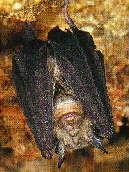Return to Rainforest Bats
'Insect Bats' or 'Microbats'

Photo: C & D Frith
Australia's Cape York Peninsula Suborder Microchiroptera Of the two suborders of bats, these are the bats most people around the world are more familiar with. This is due to the fact that they are found practically everywhere. They are a much more diverse group than the 'megabats'; there are microchiropterans that have evolved to feed on insects, fish, fruit, nectar, blood and even other bats. They are generally small and fast, with most living in colonies in dark places where they roost upside down. The saying 'blind as a bat' is a reflection of the fact that many species have small eyes and that they tend to rely on another sense to make their way around. This other sense involves emitting high frequency calls from the mouth or nose and detecting the 'ultrasounds' as they reflect off other objects. They use this echolocation sense both to navigate in the dark and to locate their prey. Many people around the world fear these bats for various reasons. Many of these reasons are unfounded, but one has to admit that when examined in the hand, they often have rather grotesque faces with various foldings in the skin. These convolutions may aid in making and collecting their ultrasonic calls (Strahan 1998). Insect bats in Australia There are six families of the microchiropteran or 'insect' bats in Australia, with over 70 species (Egerton 1997). All species in Australia are primarily insectivorous with the notable exception of the biggest Microchiropteran of them all, the 'Ghost Bat', that feeds on small mammals, including other bats (Strahan 1998 Additional Information: Large-eared Horseshoe-bat: Rhinolophus philippinensis This is an insectivorous bat. It has an elaborate nose-leaf, the U-shaped lower part looking like a horseshoe. It has long ears, is grey-brown above, and slightly lighter below. This small bat weighs only10-12g, has a head and body length of 62-65mm, tail length of 33-35mm and forearm length of 50-53mm.

Habitat and Distribution: Lives in small caves and disused mines, preferably in warm, humid areas for daytime roosting, a factor that limits their distribution (in north-eastern Queensland). It likes areas of dense vegetation such as closed canopy vine forest that allows only a little light through. It has also been seen feeding in open forest areas of Cape York Peninsula. It is rare in Australia, but common in the Philippines, Kei Islands, Celebes, New Guinea and Timor.
Diet: It feeds on moths and other flying insects, detecting its prey by using ultrasonic 'sonar' calls that bounce off objects and return signals to their sensitive ears. It usually eats from the ground, or close to it.
Social Behaviour: This bat does not seem to form large colonies. Scattered individuals are found in caves, often in association with the Eastern Horseshoe-bat (a close relative). It hangs from the ceiling (not against the wall as most species do) and only forms clusters when juveniles and young are left together while the adults are feeding.
Additional Information: - Its flight is similar to that of a butterfly due to its short broad wings. It hovers and darts among the foliage and close to the surface of water.
- If by accident it lands in water, it can take off directly from the surface as long as the fur has not become waterlogged.
- It has a very intense ultrasonic call, its pattern of cries consisting of long constant-frequency portions with a short modulated termination. The call is snorted through its nostrils and beamed directionally by the nose-leaf. This is an advantage as if the bat is flying through dense vegetation and eating a moth at the same time, it is still able to make its call. (Most other bats emit their calls through their mouth.)
- It has large ears that move rhythmically but separately from a forward-pointing to a lateral direction. This sweeping motion is thought to increase the accuracy of its echolation and is often observed as one approaches a resting bat.
|
